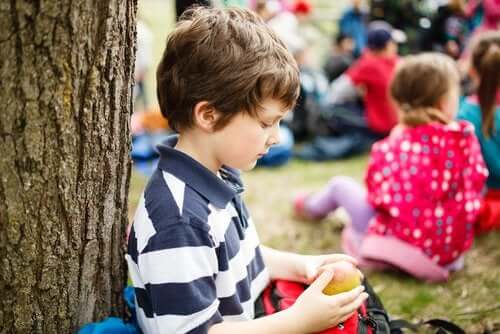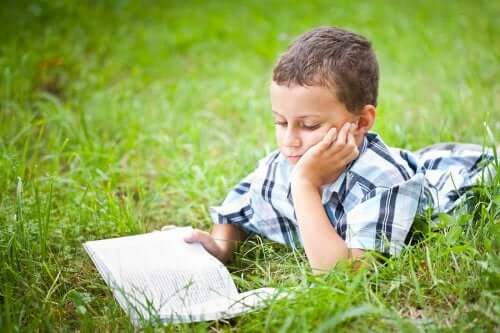Passive Children: How to Stimulate Them

It’s very easy to identify passive children. They usually avoid confrontation, arguments, and groups of people. They tend to be very loving, attentive, and try to live a very calm and peaceful life. What’s more, they’re characterized by being extremely patient. However, for this same reason, they’re also often vulnerable to becoming victims of bullying.
When it comes to passive children, they never dare to lead a group. Rather, they prefer things like playing or reading on their own. This isn’t because they have a bad attitude.
However, it’s important for these kids to cultivate a sense of self-confidence and demonstrate their autonomy. This will help them obtain the skills they need to confront any situation they may encounter.
The stimulation of passive children is very important. Why? Because through this stimulation, we can awaken the leader that’s hiding inside these little ones. Therefore, patience is key.
We need to talk to these individuals regarding their concerns, needs, and aspirations… But at the same time, we need to avoid being forceful. It’s best to allow things to flow at whatever pace the created dynamic allows for.
What are the defining characteristics of passive children?
When we talk about passive children, we’re referring to kids who share a certain set of characteristics. For example, they lack the energy and enthusiasm to carry out activities or display little interest when they’re invited to join in. They’re unable to stand up for their own rights and those of others. What’s more, they tend to isolate themselves, and don’t usually enjoy sports.
Other characteristics that define them are the following:
- They invest a great deal of time in front of the TV, computer, video games, or other technological devices.
- Passive children have a hard time relating to other kids their own age and tend not to have many friends.
- When lying down, they like to listen to music, which relaxes them.
- They don’t show initiative or willingness to carry out activities.

- They refuse to participate in competitive activities.
- These children are extremely obedient.
- They never express their feelings or emotions.
- Often, they take a long time to complete tasks.
- They prefer to be still and to observe without giving their opinions.
On many occasions, being a submissive child can be very beneficial. For example, when some problem at school emerges, you can be sure these children aren’t to blame. This is because their passivity drives them to stay away from any situation that they see as dangerous or risky.
However, this behavior can also be a cause of internal conflicts. Many times, these little ones wish they had the courage to take on any situation, but they don’t. What’s more, this can be very frustrating for them.
Their passive personalities make them the subject of constant bullying at school. Since they don’t know how to defend themselves, other children often take advantage of the situation and make fun of them.
How to stimulate passive children
Children who are passive often believe that they’re inferior to others. Therefore, they tend to shrink back when they find themselves in groups… whether the group includes their peers or adults.
In order to stimulate these little ones, it’s important to encourage changes in their behavior. To do so, we suggest the following:
Build up their self-esteem
Children who are passive have a hard time recognizing their courage. That’s why they need the support of their parents to discover how courageous they can be. What’s more, they need to learn not to let anyone cause them to doubt themselves.
We must make it clear that everyone has different talents and areas where they can stand out. And whatever strengths a passive child has are just as valuable and important. As these children’s self-esteem grows, they’ll become surer of themselves.
Stimulate their interests
It’s important to make their own interests and likes a priority. This will help them feel more confident and motivated in regards to the activities they participate in.
Also, you should encourage them to carry out the tasks they’re responsible for at home and school with the same enthusiasm. What’s good about these spaces for expression is that they can find new habits and routines that are fun, educational, and stimulating.
Educate them emotionally

Encourage them to interact with other children
You should encourage these kids to participate in activities that involve other children… especially those that are part of their environment (school, neighborhood, etc.).
Attend birthday parties, go to parks, zoos, and children’s museums, or go to special activities at your local library. These are excellent options that allow children to begin to interact with their peers.
When we stimulate passive children, we help them become children that are full of confidence. This will help them face any situation that comes their way victoriously and to learn to make the best of difficulties.
Over time, they’ll cease to question their own abilities and find the courage to take on any challenge.
It’s very easy to identify passive children. They usually avoid confrontation, arguments, and groups of people. They tend to be very loving, attentive, and try to live a very calm and peaceful life. What’s more, they’re characterized by being extremely patient. However, for this same reason, they’re also often vulnerable to becoming victims of bullying.
When it comes to passive children, they never dare to lead a group. Rather, they prefer things like playing or reading on their own. This isn’t because they have a bad attitude.
However, it’s important for these kids to cultivate a sense of self-confidence and demonstrate their autonomy. This will help them obtain the skills they need to confront any situation they may encounter.
The stimulation of passive children is very important. Why? Because through this stimulation, we can awaken the leader that’s hiding inside these little ones. Therefore, patience is key.
We need to talk to these individuals regarding their concerns, needs, and aspirations… But at the same time, we need to avoid being forceful. It’s best to allow things to flow at whatever pace the created dynamic allows for.
What are the defining characteristics of passive children?
When we talk about passive children, we’re referring to kids who share a certain set of characteristics. For example, they lack the energy and enthusiasm to carry out activities or display little interest when they’re invited to join in. They’re unable to stand up for their own rights and those of others. What’s more, they tend to isolate themselves, and don’t usually enjoy sports.
Other characteristics that define them are the following:
- They invest a great deal of time in front of the TV, computer, video games, or other technological devices.
- Passive children have a hard time relating to other kids their own age and tend not to have many friends.
- When lying down, they like to listen to music, which relaxes them.
- They don’t show initiative or willingness to carry out activities.

- They refuse to participate in competitive activities.
- These children are extremely obedient.
- They never express their feelings or emotions.
- Often, they take a long time to complete tasks.
- They prefer to be still and to observe without giving their opinions.
On many occasions, being a submissive child can be very beneficial. For example, when some problem at school emerges, you can be sure these children aren’t to blame. This is because their passivity drives them to stay away from any situation that they see as dangerous or risky.
However, this behavior can also be a cause of internal conflicts. Many times, these little ones wish they had the courage to take on any situation, but they don’t. What’s more, this can be very frustrating for them.
Their passive personalities make them the subject of constant bullying at school. Since they don’t know how to defend themselves, other children often take advantage of the situation and make fun of them.
How to stimulate passive children
Children who are passive often believe that they’re inferior to others. Therefore, they tend to shrink back when they find themselves in groups… whether the group includes their peers or adults.
In order to stimulate these little ones, it’s important to encourage changes in their behavior. To do so, we suggest the following:
Build up their self-esteem
Children who are passive have a hard time recognizing their courage. That’s why they need the support of their parents to discover how courageous they can be. What’s more, they need to learn not to let anyone cause them to doubt themselves.
We must make it clear that everyone has different talents and areas where they can stand out. And whatever strengths a passive child has are just as valuable and important. As these children’s self-esteem grows, they’ll become surer of themselves.
Stimulate their interests
It’s important to make their own interests and likes a priority. This will help them feel more confident and motivated in regards to the activities they participate in.
Also, you should encourage them to carry out the tasks they’re responsible for at home and school with the same enthusiasm. What’s good about these spaces for expression is that they can find new habits and routines that are fun, educational, and stimulating.
Educate them emotionally

Encourage them to interact with other children
You should encourage these kids to participate in activities that involve other children… especially those that are part of their environment (school, neighborhood, etc.).
Attend birthday parties, go to parks, zoos, and children’s museums, or go to special activities at your local library. These are excellent options that allow children to begin to interact with their peers.
When we stimulate passive children, we help them become children that are full of confidence. This will help them face any situation that comes their way victoriously and to learn to make the best of difficulties.
Over time, they’ll cease to question their own abilities and find the courage to take on any challenge.
All cited sources were thoroughly reviewed by our team to ensure their quality, reliability, currency, and validity. The bibliography of this article was considered reliable and of academic or scientific accuracy.
- Katy Gutiérrez. (2018) Los niños pasivos: Blanco fácil para sufrir de acoso escolar. [Online] Portal de Educación Infantil y Primaria. Disponible en: https:/www.educapeques.com/escuela-de-padres/ninos-pasivos-acoso.html
- Blair, K. A., Denham, S. A., Kochanoff, A., & Whipple, B. (2004). Playing it cool: Temperament, emotion regulation, and social behavior in preschoolers. Journal of School Psychology. https://doi.org/10.1016/j.jsp.2004.10.002
- Sweetser, P., Johnson, D., Ozdowska, A., & Wyeth, P. (2012). Active versus passive screen time for young children. Australasian Journal of Early Childhood.
- Wohlheiter, K. A., & Dahlquist, L. M. (2013). Interactive versus passive distraction for acute pain management in young children: The role of selective attention and development. Journal of Pediatric Psychology. https://doi.org/10.1093/jpepsy/jss108
This text is provided for informational purposes only and does not replace consultation with a professional. If in doubt, consult your specialist.








